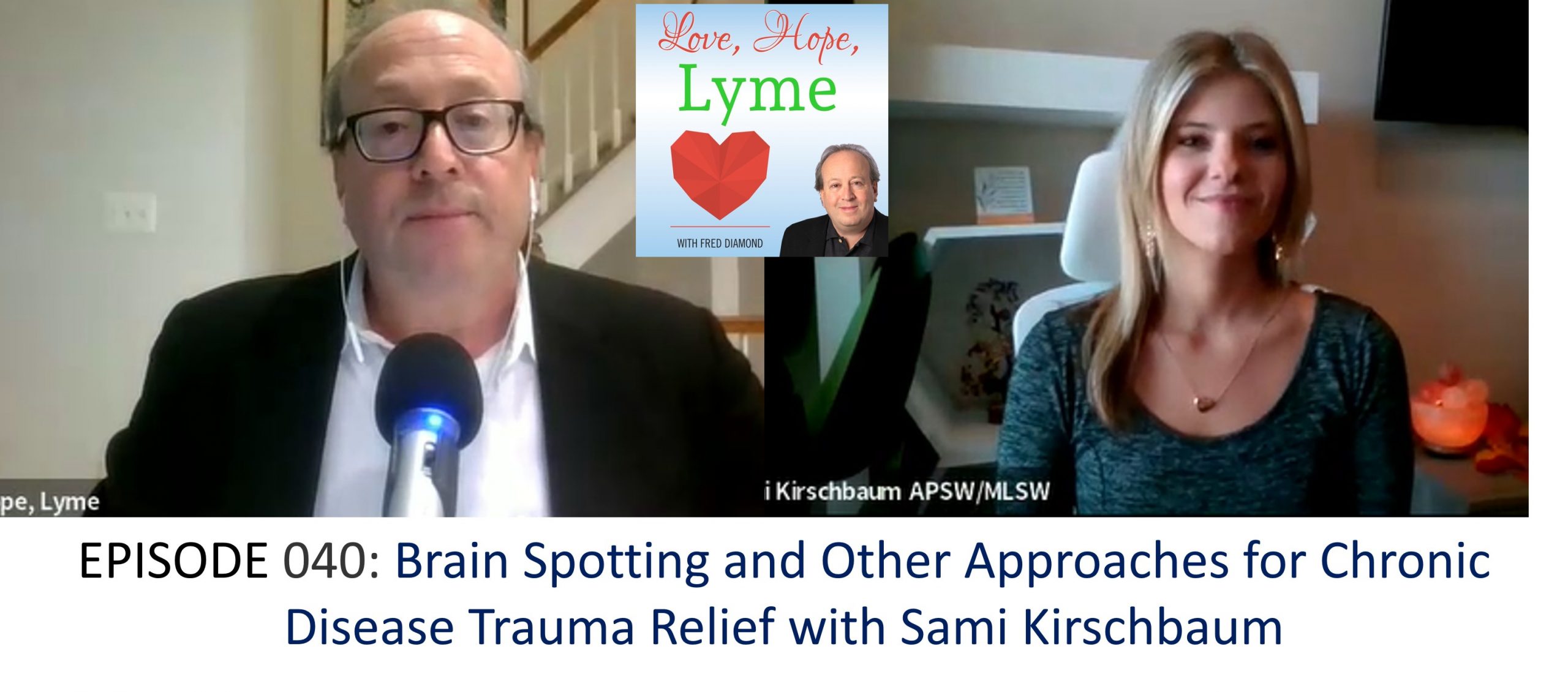PODCAST: Navigating trauma to heal from chronic Lyme

By Fred Diamond
Chronic Lyme disease often brings trauma that can worsen symptoms and hinder healing.
In this week’s Love, Hope, Lyme podcast, I bring on Sami Kirschbaum, who helps patients heal through techniques like Brainspotting and nervous system regulation.
Sami focuses on the body’s physical response to trauma and uses methods to help patients release stored trauma and regain balance.
She also emphasizes the importance of community support in the healing process, offering a holistic approach to help Lyme survivors heal both emotionally and physically.
Every chronic Lyme survivor must navigate trauma, either induced from years of poor medical care or unresolved childhood trauma that is inhibiting healing and recovery.
When I was writing my book “Love, Hope, Lyme: What Family Members, Partners, and Friends Who Love a Chronic Lyme Survivor Need to Know,” I was surprised to see the word come up in almost every conversations. It came to a head for me when I watched a webinar with Dr. Richard Horowitz. At the 59-minute mark, Dr. Horowitz said, “By the way, if you don’t resolve your childhood trauma, it’ll be very difficult to heal.”
Chronic Lyme disease is not just a physical battle; it often comes with emotional and psychological trauma that can intensify symptoms and hinder the healing process.
Sami Kirschbaum, founder of the Lyme Resilience Collective, focuses on helping patients navigate and heal from these trauma responses through specialized techniques.
Drawing from her personal journey with Lyme disease and her training in trauma-based healing, Sami integrates Brainspotting, nervous system regulation, and community support to provide holistic care for those dealing with the emotional toll of chronic illness.
Trauma in the context of chronic illness
Many people think of trauma as the event itself, but Sami explains that trauma is really the body’s response to a stressful or overwhelming experience.
“When we go through traumatic experiences, a lot of people think that the event itself is a trauma,” she says. “But actually, what trauma is, is the person’s physical response to protect itself in a traumatic experience.”
This distinction is key for those with chronic Lyme disease, where trauma often exacerbates physical symptoms or reactivates dormant illness.
Sami’s approach to trauma healing starts with the body because, as she notes, “We know that trauma is actually held within the body. It’s not in our rational brain.”
The physical response to trauma can cause the body to remain in a heightened state of stress, which interferes with healing. This is why addressing trauma in both the mind and body is essential for those with chronic illnesses like Lyme disease.
Techniques for nervous system regulation
A central technique in Sami’s trauma healing practice is nervous system regulation. Chronic illness often puts patients in a perpetual state of stress, which she describes as being either “stuck-on” or “stuck-off.”
“The stuck-on state looks like panic, hypervigilance, high anxiety, running around, never feeling rested,” Sami explains. On the other hand, “stuck-off can look like lethargy, being depressed, shutting down, disassociating.”
Both extremes prevent the body from finding balance, or homeostasis, which is crucial for the healing process. “It’s important to have nervous system regulation so that we can stay in that flow and continue functioning appropriately through life.”
Sami offers nervous system regulation support groups as part of her services, teaching patients techniques to bring their nervous system back into balance. These techniques help patients navigate between the extremes of being stuck in high-alert states or shutting down completely.
Brainspotting: a key modality for trauma healing
One of the most powerful tools Sami uses for trauma healing is Brainspotting, a technique developed by Dr. David Grand.
“Brainspotting is a top trauma-healing modality,” Sami explains. It works by using the client’s visual field to access where the trauma is stored in the body.
Sami breaks it down further: “Where you look affects how you feel.” During Brainspotting sessions, the client focuses on a particular spot in their visual field while wearing headphones that deliver bilateral sound stimulation. This combination helps the brain and body work together to process trauma that is stored at a deeper level than the conscious mind can access.
Unlike more commonly known trauma therapies like EMDR (Eye Movement Desensitization and Reprocessing), Brainspotting allows for more flexibility and creativity.
“We trust that the person’s brain and body knows what it needs to heal itself, and the therapist, we hold the space for the client,” Sami says. The process is guided by the client’s own responses, allowing them to access and release stored trauma at their own pace.
Sami has been trained in Brainspotting for several years and credits it as one of the most effective tools for helping clients process trauma related to chronic Lyme disease. Brainspotting allows the patient to access trauma stored in the body and release it in a way that promotes both emotional and physical healing.
Trauma held in the body: healing from the inside out
A major component of Sami’s practice is helping clients recognize that trauma is stored in the body, not just in the mind. “We can’t have trauma processing from our neocortex, which is the higher part of our brain,” she explains.
This is why traditional talk therapy is often insufficient for healing trauma—especially for those with chronic illnesses.
“Trauma held in the body doesn’t have language, it has no sense of time,” Sami explains. “It just has a memory of protecting ourselves, and it is strong and sometimes gets embedded.”
This can make trauma responses seem exaggerated or irrational, but they are the body’s way of holding onto that survival mechanism. Techniques like Brainspotting are effective because they address trauma at this deep, body-based level.
Healing trauma collectively
Another important aspect of Sami’s work is the recognition that trauma and shame thrive in isolation, but healing can occur collectively. She emphasizes the importance of community in the healing process.
“Shame happens between people and it needs to be healed between people,” Sami says. By creating group settings for nervous system regulation and Brainspotting, she provides patients with a space where they can connect with others who understand their experiences.
“Coming together as a community is so important, which is why I do the group work as well as the individual work,” she explains. Chronic illness can be isolating, and many patients feel dismissed by family, friends, and even medical professionals. In Sami’s groups, patients find a safe space where they can share their experiences without fear of judgment or dismissal.
Moving beyond trauma
Sami’s ultimate goal is to help clients move beyond their trauma responses and reclaim their lives. This is why she focuses not just on trauma healing but also on cognitive rewiring and neuroplasticity.
“We can literally have neuroplasticity at our fingertips,” Sami says. “We can unlearn those programmings that we had, and then have the real adult mature brain come online and say, ‘Whoa, I am lovable.’”
For patients with chronic Lyme disease, this can mean letting go of limiting beliefs tied to their illness, such as feeling unworthy of love or incapable of leading a full life.
“Even though I can’t attend all these family events because I have chronic illness, I’m still worthy of love, I’m still worthy of belonging,” Sami says. This cognitive shift, combined with trauma healing, can help patients find emotional and physical relief.
Click here to listen to all episodes of the Love, Hope, Lyme Podcast or on YouTube.
Fred Diamond is based in Fairfax, Virginia and can be contacted via Facebook. His popular book, “Love, Hope, Lyme: What Family Members, Partners, and Friends Who Love a Chronic Lyme Survivor Need to Know” is available on Amazon. The e-version of the book is always free to Lyme survivors. PM Fred on Facebook or LinkedIn for your copy.





















We invite you to comment on our Facebook page.
Visit LymeDisease.org Facebook Page